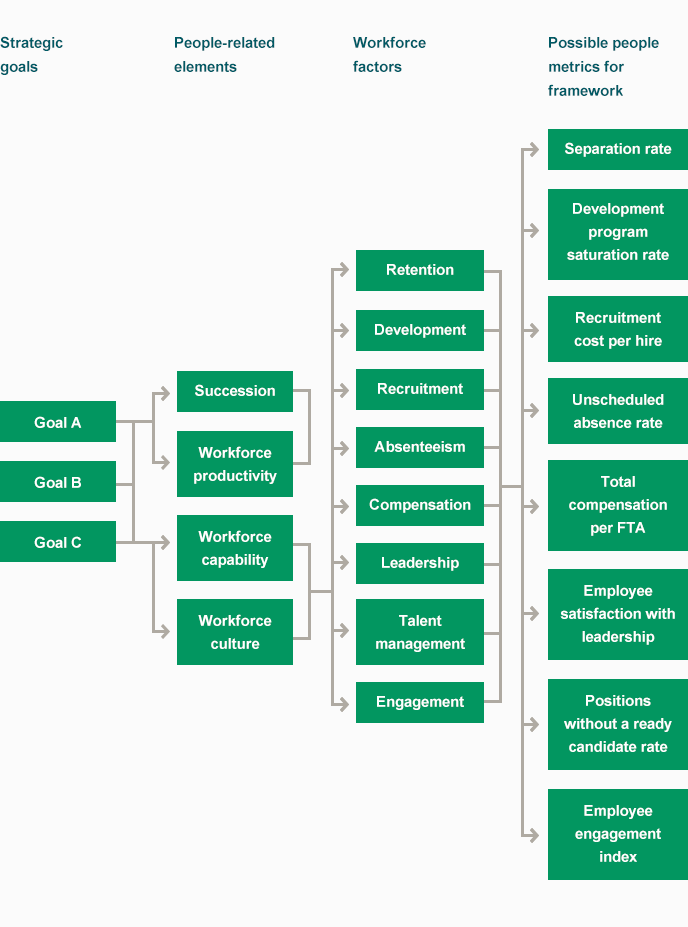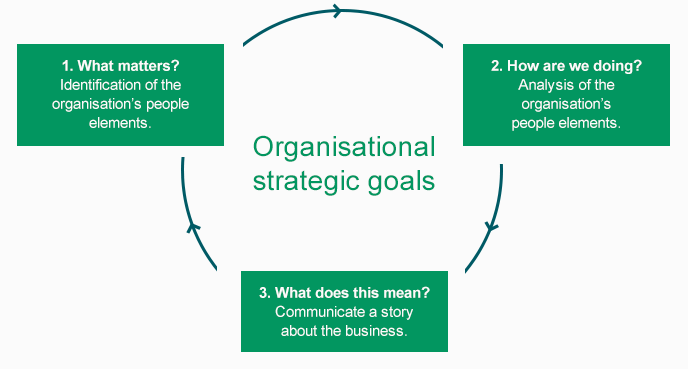Developing a People Metrics Framework
Strategic and transformational people metrics can be used by the HR function for two purposes:
- as business intelligence gathering, which is generally ad hoc or a once-off, based on an identified or hypothesised business need
- as part of a people metrics framework that is relevant to the ongoing and future needs of the organisation.
An optimal people metrics framework includes a selection of strategically aligned people metrics that will measure the workforce priorities that are most critical to the organisation’s ability to meet current and future goals.
By regularly and consistently measuring the critical workforce priorities, the organisation can monitor the environment in which it operates and mitigate any foreseeable risks with appropriate strategies.
Figure 2 represents an ‘in principle’ example of what a people metrics framework could look like. This framework makes reference to ‘people elements’ and ‘workforce factors’. These terms are defined in this publication as:
People elements – are the business considerations that are impacted by the workforce. For example, Figure 2 suggests that to successfully meet ‘Goal A’ the organisation needs to assess succession because it is a critical business consideration in meeting that goal.
It is important to note, that the people element is not an ‘issue’. However, measurement and analysis of the people element may expose it as an issue or a business risk.
Workforce factors – inform the people elements. For example, to meet ‘Goal A’ succession has been identified as a critical business consideration. Succession is impacted and informed by a number of workforce factors including retention, development and recruitment. People metrics that say something about these workforce factors will begin to build a picture about succession (the people element).
The relevance of the strategic goals presented in this framework may alter over time.
Figure 2: Example of what a people metrics framework could look like
Selecting Meaningful People Metrics
The selection of people metrics that are meaningful to the business can be a daunting task. However, people metrics are meaningful to the business if they:
- provide evidence of performance against a business need
- inform activities toward an organisational strategic objective or goal
- provide an evidence base for a strategically aligned HR opportunity.
The diagram below represents a process to consider in selecting meaningful metrics.
The underlying principle of this process is the primary consideration of the organisational strategic goals.
The stages presented in this diagram include:
- What matters? Identification of the organisation’s people elements and workforce factors. To establish the business considerations that are critical to the organisation’s ability to achieve its strategic goals.
- How are we doing? Identifying meaningful people metrics that monitor the organisation’s performance against the identified people elements. This stage includes gap identification, issues identification, and cause analysis.
- What does this mean? Communication of the findings in a way that is meaningful to the audience. The following pages further extrapolate on this model by providing some additional questions to consider.
1. What matters? Identification of the organisation’s people elements
To establish which business considerations are impacted by the workforce, use the organisational strategy to consider:
- which goals will the workforce have a critical impact on the organisation’s ability to deliver that goal
- which of the identified goals is most critical to the organisation’s overall success
- which parts of the workforce needs to be working well, to achieve the identified goal.
Having identified the people elements impacting on the organisation’s ability to achieve success, consider which workforce factors inform this people element. For example, workforce factors influencing culture include engagement, retention, performance and leadership.
From what is known about the workforce factors consider:
- what the organisation does well
- what the organisation has difficulties with
- how these workforce factors influence the people element and what successful management of the people element would look like in the organisation. This may be based on past performance, internal benchmarks, external benchmarks or labour statistics
- which questions need to be answered about the organisational people elements.
2. How are we doing? Analysis of the organisation’s people elements
To determine which people metrics will be an indicator of performance against the people element consider:
- what you need to know to get the most comprehensive measure of the identified people element – consider the identified workforce factors that inform this people element. The workforce factors will help ‘break-down’ areas of measurement
- what data is collected by the organisation and what is available from outside the organisation and if the organisation wishes to measure this people element, then consider collecting this data in future
- whether developing a hypothesis would help guide the analysis.
Working with the data need not be complicated. Simply start with one or two measures and build on that information. When looking at the data also consider:
- why any high or low results are returned from the metric and what this means
- what the possible impacts or drivers are
- what the impact of this result is on the organisation, now and in the future
- whether the meaning in the data changes when cross-analysed with another related metric, and how this further enhances the story.
3. What does this mean? Communicating a story about the business
Communicating a story about the business gives meaning to the measurement by building a narrative around the data by linking concepts back to business outcomes.
When building the narrative consider:
- what the findings say about the organisation
- whether the findings were expected
- whether the story changes when one people metric is compared to another
- what impact this will have in the future
- whether there is any missing piece of the story, or what would further enhance the story.
Presentation of the story plays a key role in how the information is received, therefore consider:
- which elements of the narrative the audience would be most interested in
- whether each use of data, or graphical representation of data, has been supported with an explanation of what it means
- whether the narrative has all the elements of a story, including beginning (purpose or scene setting), middle (content and findings) and end (recommendations and conclusions).


